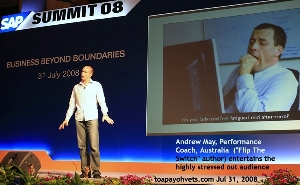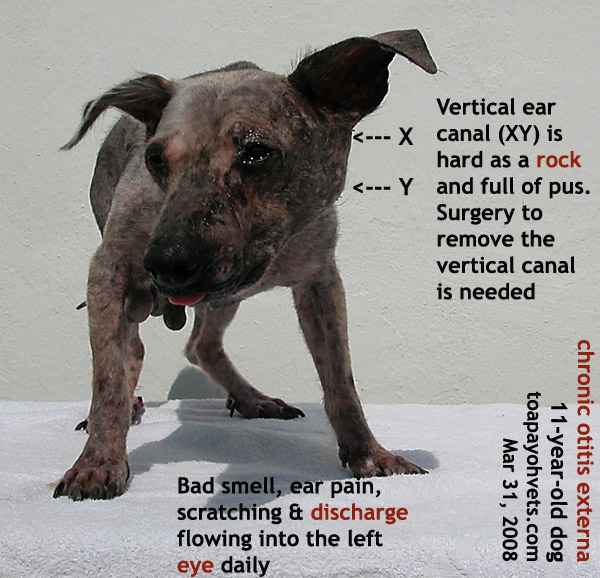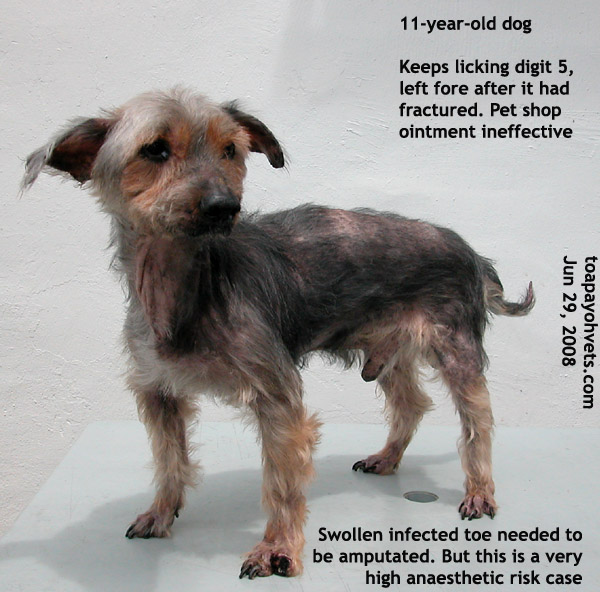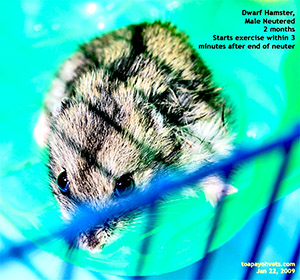 On July 9, 2008, I was attending a
breakfast Oracle Seminar on "Innovation in Asia" at St Regis Hotel
to gain some knowledge outside the scope of veterinary medicine and
surgery - a continuing education from the point of view of the
business management operators in other industries. Sometimes the
secrets of success from non-veterinarians are applicable to my
profession and very useful.
On July 9, 2008, I was attending a
breakfast Oracle Seminar on "Innovation in Asia" at St Regis Hotel
to gain some knowledge outside the scope of veterinary medicine and
surgery - a continuing education from the point of view of the
business management operators in other industries. Sometimes the
secrets of success from non-veterinarians are applicable to my
profession and very useful.In the midst of a very interesting presentation by successful applications of SAP, my phone vibrated.
 |
|
The last speaker of the SAP Summit 08 shared a different non-SAP application topic and made the mainly IT audience laugh at themselves |
The owner phoned me at 9 a.m to
say that his 11-year-old Silkie Terrier passed away in his sleep. His
dog just stopped eating for 2 days. The dog had grown hairs and was
free of ear pain after my vertical canal ablation surgery in March
2008.
 So we thought he would live for some years. Then in June 2008, the dog
injured his left foreleg's toe. The owner tried to treat it himself
but the dog just gnaw at his toe till it became much swollen. He had
to be operated under general anaesthesia again. I prefer not to
operate an old dog a 2nd time. He survived the first general
anaesthesia for his ear canal removal and it is better not to take the
risk again as old dogs are high risk patients. He was 11 years old and
he has reached the limit of his life span.
So we thought he would live for some years. Then in June 2008, the dog
injured his left foreleg's toe. The owner tried to treat it himself
but the dog just gnaw at his toe till it became much swollen. He had
to be operated under general anaesthesia again. I prefer not to
operate an old dog a 2nd time. He survived the first general
anaesthesia for his ear canal removal and it is better not to take the
risk again as old dogs are high risk patients. He was 11 years old and
he has reached the limit of his life span.
Now, this dog has a blood clotting disorder. His blood just does not
clot easily during surgery. I did not do a blood platelet test to
confirm that he had a low platelet count to save on costs for the
owner. There is no cure for the idiopathic thromobocytopenic purpura.
Idiopathic means that the cause is unknown although it is believed
that the body makes antibodies to destroy its own platelet.
This dog would be suffering from a chronic idiopathic
thromobocytopenic purpura and like the disease in people, he could
live to an old age.
 He had a left severe ear pain. Hard as a rock - that's what his left
ear vertical canal felt to me. The cure was removal of this vertical
canal, a surgery called vertical canal ablation. Now, would he die
under general anaesthesia - being aged and thin? At the time of
surgery, I did not suspect he had chronic idiopathic thromobocytopenic
purpura. In retrospect, some blackish bruises on his bald body could
be a tell-tale sign but old dogs may have such blemishes.
He had a left severe ear pain. Hard as a rock - that's what his left
ear vertical canal felt to me. The cure was removal of this vertical
canal, a surgery called vertical canal ablation. Now, would he die
under general anaesthesia - being aged and thin? At the time of
surgery, I did not suspect he had chronic idiopathic thromobocytopenic
purpura. In retrospect, some blackish bruises on his bald body could
be a tell-tale sign but old dogs may have such blemishes.
In any event, he survived the ear and toe amputation surgeries under
general anaesthesia. He lived the last few months of his life without
pain in his left ear and for that the owner was very happy that the
dog passed away peacefully. I only talked to the owner by phone and
had never met him as he is a busy person.
Tentative diagnosis of chronic idiopathic thromobocytopenic purpura in
this case as blood samples were not taken to reduce veterinary costs
to the owner:
1. blood does not clot in the ear canal before vertical canal ablation
surgery (see pictures).
2. a large haematoma after surgery (swelling above his left parotid
salivary gland and where the vertical ear canal was removed, under the
healed wound). At the toe amputation surgery, I checked the left
facial swelling which was painful if palpated. It was just blood that
did not clot. It was around 30 ml of liquid blood.
3. some purplish blood when the bandage wrapping the toe area is
removed (see picture).
4. bruises in his body.
 The dog was an extremely high anaesthetic risk and yet he survived
two anaesthesia. Gas anaesthesia at the lowest dose was given. Intubation
was done. No tranquilisers or pre-anaesthetic medication was used. No
problems encountered during the anaesthesia although this was an old
dog nearing the end of his life span. Pain-killers were given for 7 days
after surgery.
The dog was an extremely high anaesthetic risk and yet he survived
two anaesthesia. Gas anaesthesia at the lowest dose was given. Intubation
was done. No tranquilisers or pre-anaesthetic medication was used. No
problems encountered during the anaesthesia although this was an old
dog nearing the end of his life span. Pain-killers were given for 7 days
after surgery.
Vertical Ear Canal Ablation
surgery in an old dog
was my first meeting with this gentle dog. I thought he was a
hairless Chinese crested dog cross bred as he had not much hair. I was
glad that the owner did not rush to put him to sleep on March 31,
2008. His wife was against euthanasia and well, this dog spent his
last 4 months having a good time with the owner. We just did not
expect him to pass away so soon as we got to know him more and his
hair was growing back. He looked younger and handsome as his golden Silkie Terrier hair grew luxuriantly in his face and I thought he was
rejunvenated.
So his early passing away saddened me too. In a way, I was grateful
that he did not die on the operating table. This type of high risk
case can be ruinous for the veterinarian's reputation if the dog had
died on the operating table. Therefore it may be wise to pass such
cases to other vets as word of mouth referrals of poor clinical
outcome like "death at the veterinarian" is not good for any
professional.
 TOA
PAYOH VETS
TOA
PAYOH VETS